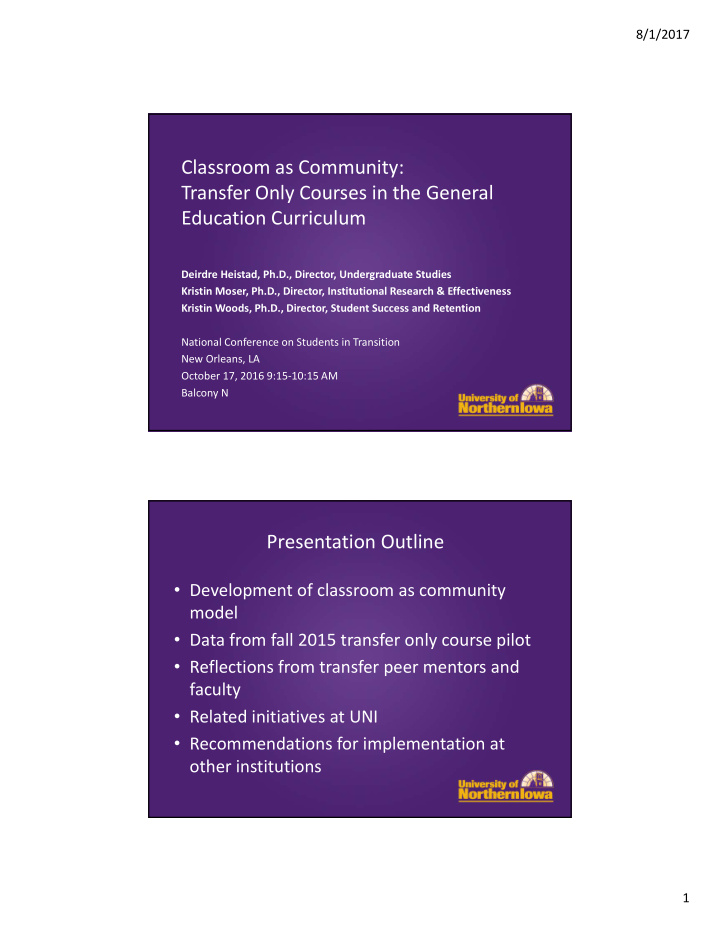



8/1/2017 Classroom as Community: Transfer Only Courses in the General Education Curriculum Deirdre Heistad, Ph.D., Director, Undergraduate Studies Kristin Moser, Ph.D., Director, Institutional Research & Effectiveness Kristin Woods, Ph.D., Director, Student Success and Retention National Conference on Students in Transition New Orleans, LA October 17, 2016 9:15‐10:15 AM Balcony N Presentation Outline • Development of classroom as community model • Data from fall 2015 transfer only course pilot • Reflections from transfer peer mentors and faculty • Related initiatives at UNI • Recommendations for implementation at other institutions 1
8/1/2017 Classroom as Community • “… for students who commute to college, especially, those who have multiple obligations outside the college, the classroom may be the only place where students and faculty meet … For these students in particular, … If academic and social involvement or integration is to occur, it must occur in the classroom” (Tinto, 1997, p. 599) Background • Foundations of Excellence – First Year – Transfer Focus • Academic Affairs/Student Affairs collaborative initiatives – Cornerstone course – Peer Mentor/First‐Year Only Program – Peer Mentor/Transfer Only – Success Coaching 2
8/1/2017 UNI Model • Embedded within existing Liberal Arts Core requirements • Collaboration among peer mentors, host faculty, Liberal Arts Core director, academic advising leadership, and student affairs staff members – Ongoing faculty development and information assessment • Peer mentoring as sophomore leadership opportunity • Formal assessment and growth Program Participation • 2011 ‐ 2012 pilot: 9 FY sections, 11 peer mentors • 2012 – 2013 : 28 FY sections, 31 peer mentors • 2013 – 2014 : 42 FY sections, 47 peer mentors • 2014 ‐ 2015 : 51 FY sections, 53 peer mentors • 2015 ‐ 2016 : 62 FY sections and 2 transfer pilot sections, 65 peer mentors • 2016 ‐ 2017 : 58 FY sections and 2 transfer sections, 60 peer mentors 3
8/1/2017 Preliminary Data • Fall term cumulative GPA: 2.97 • 29.9% live on‐campus • 93.5% persisted mid‐year • 84.4% retained into second year Preliminary Data (cont) 4.67 Participates in class? 5.00 Making connections with other 4.67 5.67 students in your major/program? Making connections with faculty 4.56 4.89 in your major/program? Committed to your 6.23 6.44 major/program? 1 3 5 7 Fall Spring 4
8/1/2017 Preliminary Data (cont) Are you satisfied with your social life 4.32 4.95 on campus? 4.80 Are you fitting in? 5.32 5.05 Do you belong here? 5.10 Satisfied with your academic life on 5.14 5.72 campus? 1.00 2.00 3.00 4.00 5.00 6.00 7.00 Fall Spring Reflections from Peer Mentors: UPDATE with Transfer FYO info • By providing them [transfer students] with opportunities and information to get involved I believe it … helped develop a sense of connection to the UNI community and establish a sense of belonging. • I feel that my instructor was awesome…! She was truly a great inspiration to me as well as the students I'm sure, and I look up to her not only in the setting at UNI but also outside of class also. I really consider her a role model and I am so grateful to have had the opportunity to work with her this year! • I loved the students!!! I could tell that they really cared about me and that they really valued my presence in the classroom. I also loved the professor that I worked with and was very happy coming to class every day. 5
8/1/2017 Faculty Reflections • The first‐year experience program and the PTAs is the best thing to have happened to my teaching in the past 10 years. • It works, I like it, I would welcome it again. It is another layer of work for the instructor, but worth it. I think we get out of the PTAs what we are willing to put in to them and their training. • Students in the classroom benefit. So do the PTAs and the instructor. I hope the PTAs will have grown, expanded their horizons, and have an appreciation for a wider range of student issues. I hope that I am a better instructor because of them. Meeting with them, hearing their opinions, having them be the "voice" of the students, that all helps me learn to do my job more effectively. • If every UNI student could take one class their first semester with a PTA in it, we could broaden their impact and also enhance faculty awareness of the needs of first‐year students, enabling faculty to modify some of the ways they approach first‐year students. Related Initiatives at UNI • Transfer‐only conferences and courses in the College of Business • Transfer Success Counseling in Financial Aid • Adding transfer‐specific programming to UNI Now extended orientation • Transfer living‐learning communities • Advocating for more transfer scholarships in academic colleges • Compiling and presenting on transfer data 6
8/1/2017 Discussion • Specific challenges related to transfer peer mentoring within LAC • Have a joint Academic Affairs and Student Affairs leadership model. • Partner with current general education curriculum • Provide faculty development on how to incorporate peer mentors into existing classes. • Support the peer mentors with training and resources. References Tinto, V. (1997). Classrooms as communities: Exploring the educational character of student persistence. Journal of Higher Education, 68 (6), 599‐623. 7
8/1/2017 Questions? Contact Information: • d.heistad@uni.edu • kristin.moser@uni.edu • kristin.woods@uni.edu 8
Recommend
More recommend